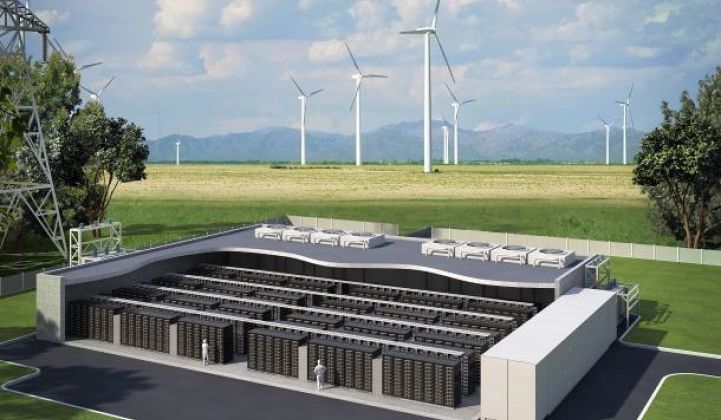California has just set a big new target for energy storage on the grid -- 50 megawatts of it, to be exact.
That’s how much energy storage capacity the California Public Utilities Commission (CPUC) is asking Southern California Edison to procure in the Los Angeles area over the next eight years, according to a final decision issued Wednesday. It’s not a lot, compared to the total of 1,400 to 1,800 megawatts CPUC is asking the massive Southern California utility to procure between now and 2021 -- but it's still among the first, if not the first, state regulatory rulings that put grid storage at center stage.
UPDATE: The decision also makes a place for energy storage technologies alongside energy efficiency, demand response and distributed generation resources, in California's Energy Action Plan, which tells utilities in which order they’re to buy the power and energy resources they need. Wednesday’s decision sets aside an additional 600 megawatts of capacity for SCE to obtain from such preferred resources, which in this case can include energy storage.
All in all, it’s a “much-needed market signal that energy storage will be considered as a key asset class to help California address its long-term local reliability and environmental quality needs,” according to Janice Lin, executive director of the California Energy Storage Alliance (CESA). CESA’s member list includes some heavyweights in batteries (LG Chem, Panasonic, Saft), as well as two ice-energy air-conditioning storage players that happen to have significant operations in California: Calmac and Ice Energy.
Wednesday’s CPUC ruling comes amidst a years-long process to set energy storage requirements for the state as it grapples with the challenges of its renewable portfolio standard (RPS) ambitions. California wants to grow its share of grid power from renewable resources (mostly intermittent wind and solar, though some baseload geothermal and biomass as well) from about 20 percent today to 33 percent by decade’s end.
That’s going to introduce huge new stability problems for the grid. Energy storage expert Ed Cazalet has predicted that California could need up to 4 gigawatts of energy storage capacity to help reach the 33 percent RPS, with both centralized, utility-scale wind power and distributed solar power as key factors to manage.
California Assembly Bill 2514, passed in 2010, called for a study of the state’s needs for grid-scale storage, but didn’t set any hard numbers on how much. The CPUC took up the issue last year, and it’s still in process.
Southern California Edison, along with big fellow state investor-owned utilities Pacific Gas & Electric and San Diego Gas & Electric, have opposed specific procurement mandates. SCE wrote in a CPUC filing that mandates “only serve to increase the return on investment of private storage developers,” while distorting the market for energy storage technologies not yet competitive in purer market terms.
There’s no doubt that many forms of energy storage -- batteries, in particular -- remain too expensive to compete against grid power. Where batteries have been deployed is in trouble spots on the grid: far-off distribution substations where batteries are cheaper than putting in new transmission lines to handle rare peak loads, or islanded grids (like Hawaii) facing an influx of on-again, off-again wind and solar power.
Of course, utilities also don’t want to be forced to engage with storage resources they don’t control -- and it’s likely they will need to be forced to open the market to third-party storage projects that work in the context of broader energy markets. Where storage is an intelligent alternative to transmission or generation build-out, and can help integrate renewables, it should be deployed. Of course, cheap natural gas also makes the status-quo approach of using peaker plants a potentially attractive option, though not so much in California, where clean air rules are the toughest in the nation.
CPUC Commissioner Michel Peter Florio, who authored Wednesday’s decision, called it a testament to the state's need to "move beyond paralysis by analysis with respect to energy storage" -- an apparent sign of impatience with the slow approach being taken to AB 2514 implementation. We’ll see if the CPUC applies similar logic to decisions for PG&E and SDG&E.
California is home to several large-scale energy storage project funded by Department of Energy smart grid stimulus grants. PG&E is building a 300-megawatt, 10-hour compressed air energy storage (CAES) system in the Central Valley, and Southern California Edison has been working with A123 Systems on an 8-megawatt, 32 megawatt-hour lithium-ion battery warehouse of sorts in the Tehachapi mountain range. Both are aimed at stabilizing and integrating the state’s wind power resources into the grid.
We’re also seeing some examples of distributed energy storage emerge, though far smaller in scope and just getting started, with everything from backyard or garage batteries to backup solar installations (Tesla and SolarCity, Silent Power and Hanwha) to substation-scale grid balancing units in the 1-2 megawatt range (Greensmith and SDG&E).



